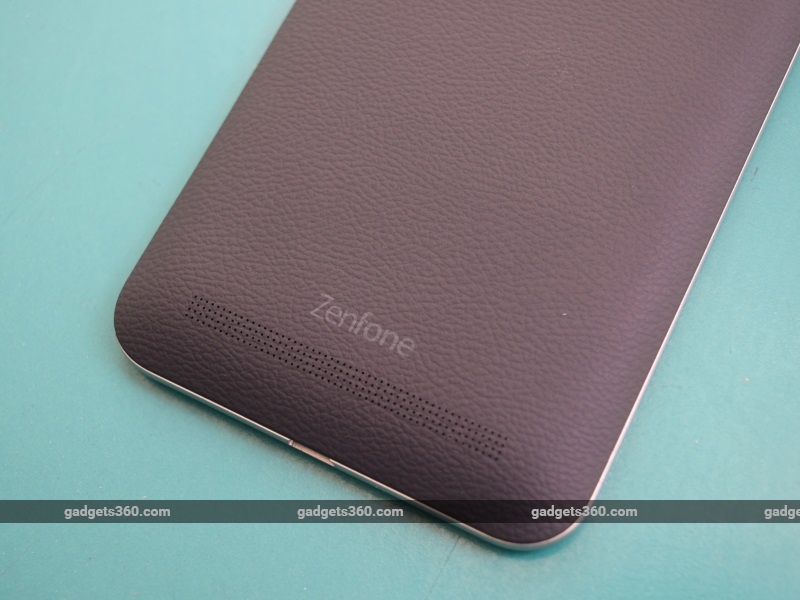- Home
- Mobiles
- Mobiles Reviews
- Asus ZenFone Max (2016) Review
Asus ZenFone Max (2016) Review

That's where the refreshed Rs. 9,999 Asus ZenFone Max (2016) comes in. This new phone hopes to offer the same fantastic battery life that was the signature feature of its predecessor, along with upgrades in other departments that will make the phone a better all-rounder. It's also being offered at the same price as what the original ZenFone Max was launched at, so it's interesting to see if this will inject new life into the series. Find out what the upgrades are, as well as how the new ZenFone Max (2016) fares, in our review.
Look and feel
The ZenFone Max (2016) is visually and physically identical to the previous version, from its dimensions to its weight. This includes the detachable back cover, gold trim along the sides, and the trademark Asus chin with concentric circles. There are, however, two new colour options for the 2016 version: blue and orange. If you go for the black or white options, you pretty much can't tell the old ZenFone Max and the new one apart.
As far as design and layout is concerned, the ZenFone Max (2016) sticks to the basics. The power and volume keys are on the right, the Micro-USB port is at the bottom and the 3.5mm audio socket is at the top. The rear panel is removable, revealing the two SIM slots and an expandable storage slot. The battery is visible under a regulatory sticker, but it isn't user replaceable. Asus' design cues essentially remain unchanged even well into 2016, and we'll have to wait till the ZenFone 3 launches for any changes on that front.
One lack of change where it would have been nice is in the use of the same 5.5-inch 720x1280-pixel IPS screen. Despite the Rs. 9,999 price tag (Rs. 12,999 for the 3GB RAM variant), Asus is not offering a suitably high-resolution screen, which is a disappointment when you consider other phones such as the Coolpad Note 3 Plus (Review) offer a full-HD and 3GB RAM at a lower price. Additionally, there's no fingerprint sensor on the ZenFone Max (2016), which is another disappointment considering the competition.
The screen itself is the same as before, with the low resolution likely maintained in favour of battery life. If that's your main concern, the low resolution and lack of detail in the screen may be acceptable to you, but for a phone that should hope to be more of an all-rounder this seems like a missed opportunity to improve things.
Specifications and software
Specifications are where the biggest differences between the two generations of the ZenFone Max can be seen, with the new one sporting the more powerful Qualcomm Snapdragon 615 SoC. Although now old and superseded by more capable options, the 615 is definitely an upgrade over the Snapdragon 410 in the older ZenFone Max. Another key upgrade is the bump from 16GB to 32GB of internal storage. In the lower-end variant of the new ZenFone Max (2016), the RAM remains the same at 2GB, but the Rs. 12,999 variant bumps this up to 3GB. It's also worth noting here that the Rs. 3000 cost for the extra 1GB of RAM seems rather steep to us, since there are no other differences between the two variants.
What remain unchanged are the 5000mAh battery and incredibly inadequate charger. Although the power output has been improved ever so slightly to 5.2W, it's still far too weak for a phone with a 5000mAh battery, and it takes over five hours to fully charge this phone. You will want to use a different charger if you do end up buying the ZenFone Max (2016).
The 2016 variant steps up to Android Marshmallow out of the box. Asus had listed which of its phones would receive the update to Marshmallow earlier this year and the old ZenFone Max is on this list, so it seems logical that the new device should come with the new software pre-installed. A lot of Android M's key features do make an appearance, including Do Not Disturb Mode, Doze Mode, Now On Tap, and revamped app permissions.
However, the user interface on top is still Asus' ZenUI, which seems to have gotten more intrusive and frustrating since we reviewed the ZenFone Max. On first boot, about 50 apps immediately needed to be updated. Additionally, apps and services are constantly pushing notifications to you for various things, such as setting up a particular account, activating the battery saver mode, or controlling the way a particular app interacts with the device. The interface does have its advantages though, notably separating some apps from the system allows for a more efficient way of handling updates, and less load on the system.
Camera
The old ZenFone Max used the same camera and laser autofocus system as the Asus ZenFone Laser, which ensured decent camera performance for the price at the time of its launch. The 2016 variant has the exact same camera as before, with a 13-megapixel sensor at the back and a 5-megapixel shooter at the front. The dual-tone LED flash and the laser autofocus window sit on either side of the rear camera, and both cameras are capable of recording video at up to 1080p-30fps resolution.
The camera app has been ever so slightly improved. The settings menu is a bit neater than before, but most of the app remains unchanged. There are plenty of photography modes, and focusing is incredibly quick and accurate thanks to the laser system. The sheer number of controls may be overwhelming for some, but sticking to auto mode will usually ensure good results.
(Tap to see full-size image)
Camera performance is predictably unchanged from the previous two Asus phones that use the same camera and focus system. Indoor shots are great, as are close-ups. Outdoor shots tend to wash out a bit, but are acceptably decent nonetheless. Shooting outdoors will still render the laser autofocus system useless and revert to traditional contrast detection methods, but the ability of the camera to focus and shoot macros is as good as ever. Videos and shots with the front camera are decent, especially in 1080p-30fps mode.
(Tap to see full-size image)
Performance
The differences between the old Asus ZenFone Max and the 2016 variant are most noticeable in the performance of the phones. While the old device used the budget Snapdragon 410 SoC, the new device has been upgraded to the more powerful Snapdragon 615. A common sight on mid-range phones last year and at the beginning of 2016, the Snapdragon 615 is a proven performer, and assures decent and reliable functionality. However, similarly priced phones are offering better, more powerful options these days, and a lot of users may not like the idea of an old SoC.
Performance on the Asus ZenFone Max 2016 is good as expected, with comfortable handling of most tasks, including gaming. Benchmark scores are what we would typically expect from a Snapdragon 615-powered device, with 41,306 in AnTuTu, 26,071 in Quadrant, 24fps in GFXBench and 9,936 in 3DMark Ice Storm. These scores are a definite improvement over the earlier Asus ZenFone Max.
Basic functionality is decent as well, with good decent call quality, good reception on both Wi-Fi and mobile networks, including strong 4G connectivity when available. The single rear-facing speaker is a bit weak, but sound quality is acceptable when using headphones.
When it comes to battery life, the Asus ZenFone Max (2016) lives up to our expectations. The phone ran for 18 hours, 4 minutes in our video loop test, which is a fair bit less than the 25 hours that the original ZenFone Max ran for, despite the battery being the same capacity at 5000mAh. This is expected, as the Snapdragon 615 is not as energy-efficient as the Snapdragon 410, and this impacts battery life to some extent. However, it's still excellent, and the phone ran for two full days with ordinary use.
Verdict
The Asus ZenFone Max (2016) is certainly a decent attempt by the company to capitalise on one of its best-selling recent products and infuse new life into it considering the competitors that have launched since January. The phone delivers improved performance to make it a little more capable, while continuing to offer excellent battery life and a good camera. Although battery life isn't up to the same stellar levels as the original, it's still more than enough to set the phone apart.
However, Asus has neglected to make improvements in other key areas. A fingerprint sensor would have helped boost the value of the phone massively, especially considering that many phones in this price range offer this feature now. 3GB of RAM should have been standard at Rs. 9,999, and the Rs. 3,000 premium for an extra gigabyte of RAM makes no sense to us. ZenUI has gotten worse instead of better. And although this would have impacted battery life further, we still feel that a full-HD screen would have been more attractive.
Despite all of this, the Asus ZenFone Max (2016) still remains a great phone to buy in the sub-Rs. 10,000 price segment if battery life is important to you. The performance boost keeps it relevant despite the lack of other improvements and additions, and so this phone is certainly worth considering if you're looking to buy a new phone at under Rs. 10,000 right now.
Catch the latest from the Consumer Electronics Show on Gadgets 360, at our CES 2026 hub.
Related Stories
- Samsung Galaxy Unpacked 2025
- ChatGPT
- Redmi Note 14 Pro+
- iPhone 16
- Apple Vision Pro
- Oneplus 12
- OnePlus Nord CE 3 Lite 5G
- iPhone 13
- Xiaomi 14 Pro
- Oppo Find N3
- Tecno Spark Go (2023)
- Realme V30
- Best Phones Under 25000
- Samsung Galaxy S24 Series
- Cryptocurrency
- iQoo 12
- Samsung Galaxy S24 Ultra
- Giottus
- Samsung Galaxy Z Flip 5
- Apple 'Scary Fast'
- Housefull 5
- GoPro Hero 12 Black Review
- Invincible Season 2
- JioGlass
- HD Ready TV
- Laptop Under 50000
- Smartwatch Under 10000
- Latest Mobile Phones
- Compare Phones
- OPPO Reno 15 Pro Max
- Honor Win RT
- Honor Win
- Xiaomi 17 Ultra Leica Edition
- Xiaomi 17 Ultra
- Huawei Nova 15
- Huawei Nova 15 Pro
- Huawei Nova 15 Ultra
- Asus ProArt P16
- MacBook Pro 14-inch (M5, 2025)
- OPPO Pad Air 5
- Huawei MatePad 11.5 (2026)
- Xiaomi Watch 5
- Huawei Watch 10th Anniversary Edition
- Acerpure Nitro Z Series 100-inch QLED TV
- Samsung 43 Inch LED Ultra HD (4K) Smart TV (UA43UE81AFULXL)
- Asus ROG Ally
- Nintendo Switch Lite
- Haier 1.6 Ton 5 Star Inverter Split AC (HSU19G-MZAID5BN-INV)
- Haier 1.6 Ton 5 Star Inverter Split AC (HSU19G-MZAIM5BN-INV)


















